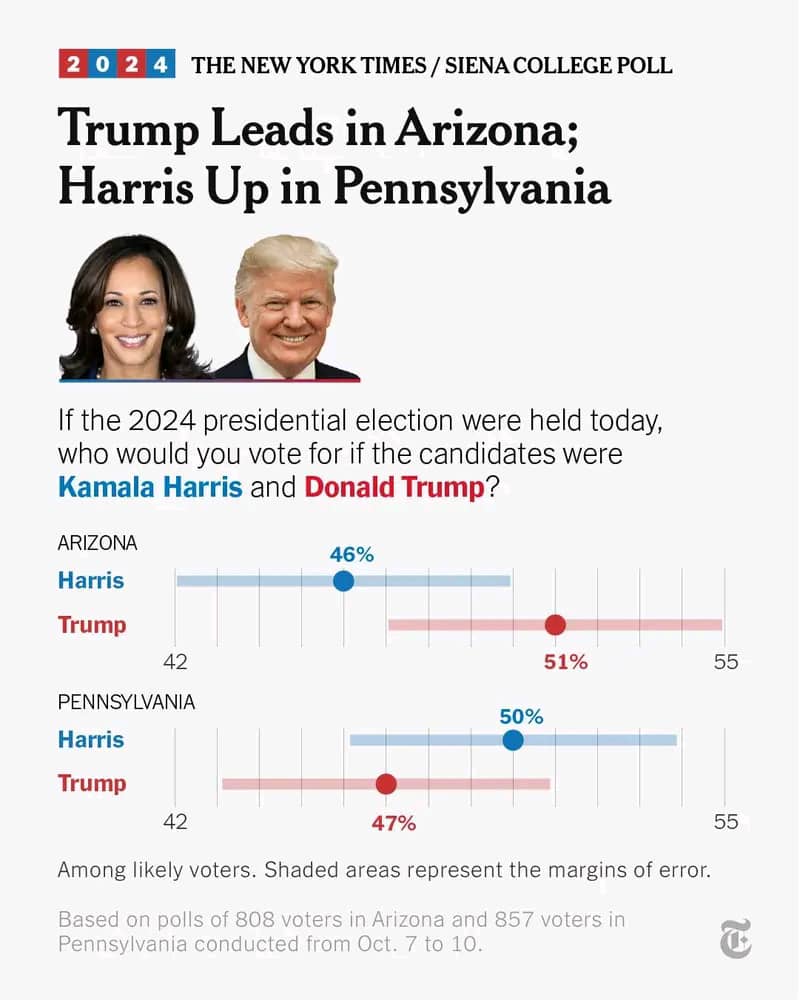By Burnett Munthali
Recent polling data from a collaborative effort by The New York Times, Philadelphia Inquirer, and Siena College reveals a fascinating snapshot of the political landscape as the nation gears up for the next presidential election. The polls indicate that former President Donald Trump is maintaining a solid lead in Arizona, while Vice President Kamala Harris appears to have the upper hand in Pennsylvania. These findings not only highlight the distinct electoral dynamics in these two critical battleground states but also provide insights into the potential challenges each party may face as the election approaches.
According to the poll results, Donald Trump continues to resonate with voters in Arizona, showcasing a significant lead over his potential rivals. His strong performance can be attributed to several factors, including his enduring popularity among the Republican base and the effective messaging that has characterized his campaign. Trump’s emphasis on issues such as immigration, economic recovery, and law enforcement seems to align well with the priorities of Arizona voters.
- When the State House Became a Vestry: How Diplomatic Missions Were Turned into Feeding Troughs
- MCP comeback appears increasingly unlikely
- BMTV tells Mhango one reason – fresh inquiry
- Kamphangala thanks MCP youth for shunning demos meeting
- Malawians Demand Transparency as Tollgate Revenues Rise but M1 Road Deteriorates
Trump’s ability to connect with key demographic groups, including working-class voters and those concerned about border security, has also contributed to his lead. As Arizona remains a crucial swing state, the Republican Party is likely to focus its resources on maintaining and expanding this support as the election nears.
In stark contrast, the polls indicate that Kamala Harris holds a lead in Pennsylvania, a state that has historically been pivotal in presidential elections. Harris’s advantage can be linked to her appeal among suburban voters and minority communities, who are crucial to the Democratic coalition. Her campaign has focused on issues such as healthcare, social justice, and economic equity, which resonate strongly with Pennsylvania’s diverse electorate.
Additionally, Harris’s position as Vice President has afforded her visibility and influence, allowing her to advocate for policies that align with the interests of Pennsylvania voters. The support she garners in urban centers like Philadelphia and Pittsburgh is vital for her campaign, and maintaining this edge will be essential for Democrats as they aim to secure the state’s electoral votes.
The divergent polling results in Arizona and Pennsylvania underscore the challenges both parties face in solidifying their support bases. For Trump, sustaining his lead in Arizona will be critical as he aims to replicate his 2016 success in the state. Conversely, Harris will need to fortify her support in Pennsylvania to ensure that it remains a Democratic stronghold.
As the election approaches, both parties will undoubtedly ramp up their campaigning efforts in these key states. The contrasting dynamics in Arizona and Pennsylvania serve as a reminder of the complex and varied electoral landscape in the United States, where different regions can prioritize distinct issues and candidates.
The latest polls from The New York Times, Philadelphia Inquirer, and Siena College offer a compelling glimpse into the current state of the race. With Donald Trump holding a lead in Arizona and Kamala Harris gaining traction in Pennsylvania, the 2024 election is shaping up to be a highly competitive contest. As voters prepare to make their voices heard, the strategies and messaging employed by both parties in these critical battlegrounds will play a pivotal role in determining the outcome of the election. The coming months will be crucial as candidates intensify their efforts to win over the electorate in these states, ultimately influencing the national political landscape.




